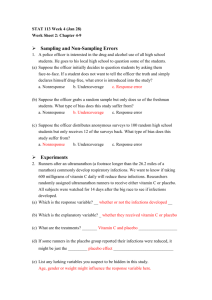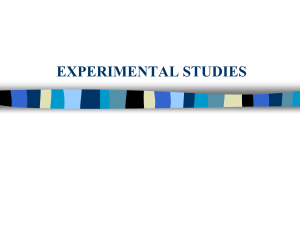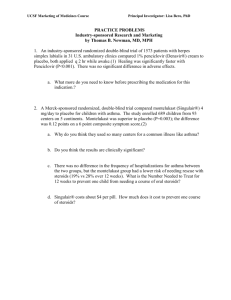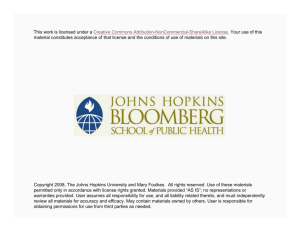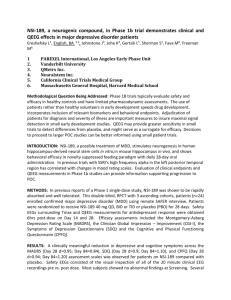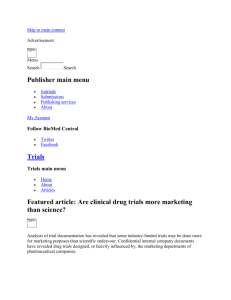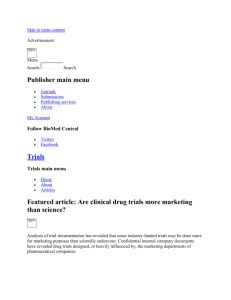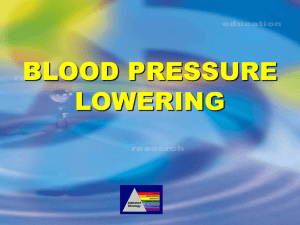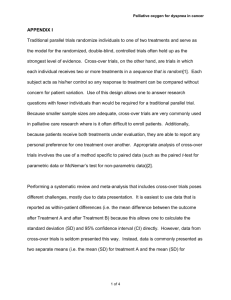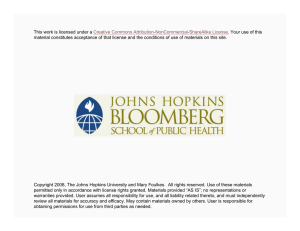critical-appraisal
advertisement
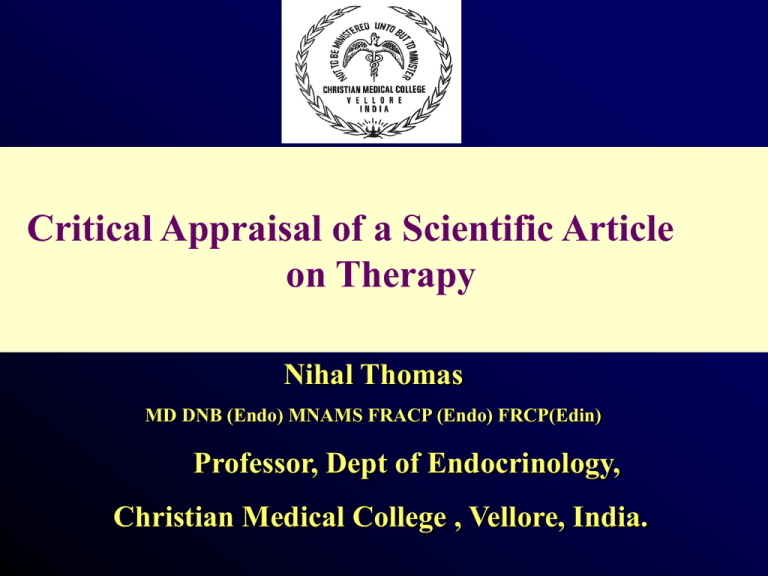
Critical Appraisal of a Scientific Article on Therapy Nihal Thomas MD DNB (Endo) MNAMS FRACP (Endo) FRCP(Edin) Professor, Dept of Endocrinology, Christian Medical College , Vellore, India. Phases of Trials • Phase 1. In a small number of normal subjects • Phase 2. In those with the disorder, few centers, moderate numbers • Phase 3. Calculated sample size, multicentric, longer duration • Phase 4. Post marketing, post-release • Why conduct therapeutic trials? To Distinguish Harmful from Useful Therapy Is the Trial really Randomized? Why Randomize? Elimination of bias a) Balances known and unknown covariates (cofactors) on average across treatment groups. b)Provided that each observation is independent of the others, validity of statistical test is assured without additional assumptions. Nonrandomized trials: False acceptance of treatment modality Eg. Human insulin over Porcine/Bovine insulin Exception to randomization: Marked reduction in mortality/ Universal response eg.1.Introduction of SM in Tb meningitis 2. Acetaminophen in fever Ensure that all clinically relevant outcomes are reported Eg. Conclusion: Folic acid reduces neural tube defects Based on: a) All sonological findings at the 14th week of GA. b)All live term neonates on the 1st day of life. Problem?? Ensure: Is the clinical statement relevant in your population 1.Statement: Vitamin D prophylaxis helps in the prevention of hip fractures. Question: Replicate the application of the study in the Indian population Catch: Mean age of patients at analysis: 83-86 years. Sunlight factor in Tropical countries (?) 2.Statement: A study in Japan shows that Drug M reduces the occurrence of Grave’s disease with thyrotoxic periodic paralysis from 30 cases in 150- to 5 in 140. Question: Conduct the study in India Catch: thyrotoxic periodic paralysis is seen almost exclusively in oriental subjects. Ensure that both clinical and statistical significance are considered in analysis Statement: In a randomized controlled trial in New Delhi, Losartan reduces blood pressure more than Atenolol in 7,000 patients. p<0.0001. Catch: Losartan reduces diastolic by 3.2mmHg > Atenolol: 79mmHg vs 82mmHg. “Over-powering” can make the p-values high right across the board In a randomized controlled trial in New Delhi, Losartan reduces blood pressure more than Atenolol in 7,000 patients. p<0.0001. Same study: Total cholesterol. p <0.05 Fasting Plasma glucose. p<0.05 Weight . P<0.05 P-value Interpretation P< 0.01 very strong evidence against H0 0.01< = P < 0.05moderate evidence against H0 • 0.05< = P < 0.10 suggestive evidence against H0 • 0.10< = P little or no real evidence against H0 Common Misinterpretations of the p-value In a study where p<0.01 ……………………… There is a 1% chance of observing a difference as large as you observed even if the two population means are identical (the null hypothesis is true) - Correct There is a 99% chance that the difference you observed reflects a real difference between populations, and a 1% chance that the difference is due to chance-Incorrect Ensure that the therapeutic maneuver is feasible in your practice Statement: Aspirin prophylaxis reduces the incidence of Myocardial infarction significantly. Comment: Cheap, Easily available. Statement: Parathyroid hormone: 1-34 is effective in the therapy of osteoporosis, if used long-term Catch: It costs 20,000/- per month in India Involves daily injections Ensure: Were all patients who entered the study accounted for at it’s conclusion? Were drop-outs,non-compliers and those who crossed-over handled appropriately ? • eg: Drop-outs in drug trials in tuberculosis should be followed up and the morbidity/ mortality assessed. “Intention to treat” (ITT): Analysis includes all randomized subjects regardless of compliance with the protocol. ITT is the only analysis that preserves benefits of randomization. As opposed to: “As treated” Intention to treat • Eg: In “ORIGIN”: looking at cardiovascular morbidity and mortality with the impact of tight glycaemic control Drop outs may occur. Follow up drop outs with a phone call: - just one question: are they alive Contamination: Azidothymidine trials- controls started popping the cases tablets (and vice-versa): Solution: Check MCV in controls and cases. • Were phenomena like contamination and co-intervention accounted for? Co-intervention: Therapeutic trials in patients with hypertension: local doctors may start separate medications that effect the trial treatment. Have Strategies been used to optimize data usage and patient numbers? • Stratification • Cross-over design • Factorial design • ‘Piggy-backing’ questions Stratification at Randomization Stratification to group patients who are similar - may reduce variability and increase power - ensure treatment balance within important subgroups; Cross-Over Design Cross-over studies in diabetes mellitus; wash-out time to be accounted for in drugs with prolonged effect eg. Pioglitazone. Anti-neuropathic medications Factorial Design Cancer: Beta Carotene Yes Heart Disease: Aspirin Yes No No “Piggy-back”…scientific questions to optimize data-extraction eg. In a study to assess diabetes therapy in Ramzan, other questions were asked: A sub-study was performed to assess dietary intake comparing subjects behaviour: pre-Ramzan and during Ramzan Scrutinize the Data---carefully: look for flaws Baseline Characteristics in a study….. Parameters Drug X Placebo Age 45 ± 9 45 ± 9 Duration of DM 8.0 ± 2 8.5 ± 2.2 Body Wt (Kgs) 66.99 ± 12 62.04 ± 8.4 BMI 29.8 ± 5.0 29.4 ± 5.4 S.Fructosamine 320.46 ± 80.16 330.64 ± 92.27 AC 157.47 ± 53.04 162.77 ± 55.19 2h PC 229.62 ± 73.45 247.03 ± 75.68 Weight between Placebo & Drug X…… 62.05 Placebo 61.59 66.99 Drug X 70.01 56 58 60 62 64 66 Weight (Kgs) End of Study Baseline 68 70 72 Has the Sample size been properly calculated? • Primary outcome measure: eg. Patients with: Severe hypoglycaemic attacks with known Drug A= 30% in 12 weeks Severe hypoglycaemic attacks expected with drug X= 15%. If possible scrutinise the study where the previous study with drug A has been performed: look for:- frequency of glucose monitoring - duration of study - Nature of subjects: potential for hypoglycaemia unawareness ************** Ideally the situation should be similar Assessment of Primary Outcome Measures • Final conclusions should be based on the primary outcome measure: Eg: Drug A does not cause Hepatitis more than placebo in a 1 year study. But sporadic cases are seen. The 1 year study: is not powered to assess the potential of Hepatitis being a siginificant side effect of the drug. Longer study required. Sample size should be larger. Cost Analysis should be performed Direct cost per month per patient analyzed In a particular trial: • Pioglitazone arm = INR 780.62 (US$ 147.36) • Placebo arm = INR 1232.50 ( US $ 27.41 ) In India vs Pioglitazone arm in India: US$ 17.36 THANK YOU


